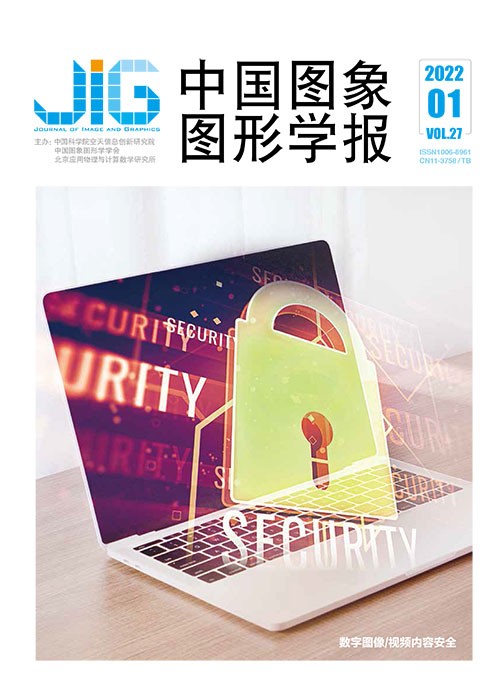
块截断编码的图像自嵌入半脆弱水印算法
摘 要
目的 数字图像自嵌入水印技术是解决图像篡改检测和恢复问题的主要技术手段之一,现有的自嵌入水印技术存在着认证粒度不高、嵌入水印后的图像失真较大,且无法抵抗滤波等操作。为提高图像自嵌入水印的认证粒度以及抵抗滤波等处理操作的能力,提出了一种基于块截断编码的图像自嵌入半脆弱水印算法。方法 水印生成与嵌入:首先,将图像进行块级别的二级划分,分别生成粒度为4×4和2×2的图像块;然后,利用块截断编码对每个4×4图像块进行压缩编码,生成2×2图像块的恢复水印,并对恢复水印进行哈希生成2×2图像块的认证水印;最后,将恢复水印和认证水印级联构成自嵌入水印,嵌入到映射块中。篡改认证与恢复:首先,将某个4×4图像块提取的水印与该块生成的水印比较,判别该图像块的2×2子块是否通过认证;最后,依据认证结果对2×2图像块实施恢复。结果 该算法产生的水印图像的峰值信噪比(peak signal-to-noise ratio,PSNR)均高于44 dB,在50%的篡改率下,恢复后的图像质量可达到32.7 dB。该算法生成水印并在图像上嵌入大约需要3.15 s,恢复图像大约需要3.6 s。结论 算法利用块截断编码,有效缩短了生成的水印长度,保证嵌入水印后图像的质量。此外,通过引入的可容忍修改阈值,使得水印能够对滤波等图像处理操作具有一定的鲁棒性,同时保证对图像的恶意篡改具有敏感性。最后通过与最近典型方法的对比实验,验证了算法在嵌入水印后图像质量、恢复图像质量等方面的优势。
关键词
Image self-embedding semi-fragile watermarking algorithm based on block truncation coding
Wang Yilong1, Li Zhenyu1, Gong Daofu1, Ma Shixin2, Liu Fenlin1(1.PLA Strategic Support Force Information Engineering University, Zhengzhou 450000, China;2.National Defense University of People's Liberation Army (PLA), Beijing 100091, China) Abstract
Objective Digital images have become the main interface for people to acquire and disseminate information. People can easily replace digital image content with fake to achieve a certain purpose via widespread availability of image processing and editing tools. Hence, it is one of the research hotspots in the field of information content security to judge the authenticity of the content of the digital image, and even restore the tampered area. Digital image self-embedding watermarking technology is one of the key technical implications constrained by low authentication accuracy and extremely quality loss without filtering. In order to improve the authentication accuracy and the resistance to filtering and other processing operations, a semi-fragile image self-embedding watermarking algorithm based on block truncation coding is proposed.Method 1) Watermarking generation and embedding:the image is divided into 4×4 image blocks, and each 4×4 image block is further divided into 2×2 image blocks. Then, block truncation coding is used to compress and encode each image block as the self-embedding watermarking information of the image block, and hash the self-embedding watermarking as the authentication watermarking information of the image block. At last, the self-embedded watermarking information and the authentication watermarking information form the watermarking information, which is embedded in the mapping block. 2)Tampering detection and recovery:At the beginning, the authentication watermarking information of 4×4 blocks is compared to identify the tampering of the image block, and then set a threshold to determine the tampering of the 2×2 image blocks based on the block truncation coding information and restore it. The algorithm uses block truncation coding to effectively shorten the watermarking information generated for 4×4 image blocks. The watermarking information is just embedded in the lowest two bits of the pixel, the quality of the image is guaranteed following the embedded watermarking and 2×2 image targeted blocks based on interpolation of the quantized information, Eventually, the 2×2 image blocks is restored based on the authentication analysis. The algorithm uses block truncation coding, which effectively shortens the length of the generated watermarking and guarantee the quality of the image while the watermarking is embedded. In addition, the watermarking can be robust to image processing operations such as filtering via the introduction of a tolerable modification threshold in terms of the inspection for tampering of images.Result The illustrated algorithm demonstrates that the peak signal-to-noise ratio(PSNR) of watermarked images generated are all higher than 44 dB, and the quality of the restored image can reach 32.7 dB at tampering rate of 50%. The algorithm takes about 3.15 s to generate and embed watermarking on an image, and it takes about 3.6 s to restore an image. The demonstration analyzes the authentication after smoothing filtering, and verifies that the algorithm has certain robustness to smoothing filtering, and the effect of resisting Gaussian filtering is the most qualified. The robustness of the mean and median filtering is the strongest when the filter core is 3×3, and more than 90% of the image blocks can be authenticated. The robustness of the mean and median filtering still decreases with the increase of the filter core. The robustness to Gaussian filtering is the strongest when σ is 0.4, and more than 95% of the image blocks can be authenticated. The robustness of Gaussian filtering decreases with the σ increase. In addition, multi-sets of threshold experiments have been conducted to analyze the impact of the algorithm' s threshold setting in the context of the robustness of smoothing filtering. The results demonstrate that the larger the threshold is, the stronger the robustness generated. The algorithm is still sensitive to severe tampering while the threshold increases.Conclusion Tampering and filtering of different scene images is evolved. The illustration of the tolerable modification threshold is sorted out watermarking. It demonstrates that the algorithm can realize the authentication and recovery of the tampering of the local area of the image. Qualified robustness is obtained via regularized processing, such as mean, median and Gaussian filtering. As a result, the comparison with the current methods verifies the advantages of the algorithm in image quality in accordance with watermarking and restoration of image quality.
Keywords
semi-fragile watermarking self-embedding block truncation coding tampering authentication tampering recover
|



 中国图象图形学报 │ 京ICP备05080539号-4 │ 本系统由
中国图象图形学报 │ 京ICP备05080539号-4 │ 本系统由